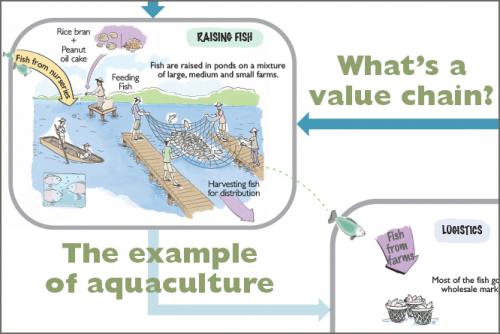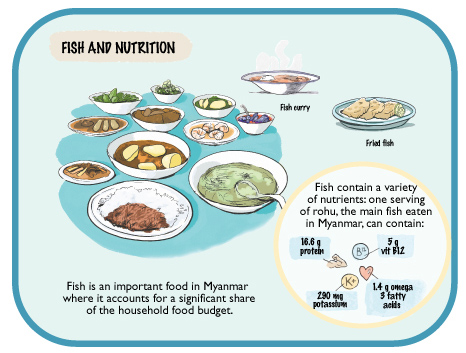What Is a Value Chain? The Example of Aquaculture
Aquaculture (fish farming) is a fast growing economic sector in SE Asia. Farmed fish is an integral part of the poor diet, and contributes to food security.
A value chain is the entire series of activities and transactions needed to make a product and deliver it to consumers.
Below is an infographic that represents the different steps that constitute a value chain, taking the example of fish farming (aquaculture), from fish eggs in farms to the consumers’ plate. A value chain is a key concept to understand agri-food system economics and development. It considers all the stakeholders that intervene and interact in food production and consumption. It shows the links between different activities and economic sectors.
Recent studies show that aquaculture is fast developing in SE Asia and challenge previous assumptions, for example that aquaculture is mainly for export. They show that farmed fish is mainly consumed locally and that it can be a main source of protein for the poor and contribute to food security. The question is also open regarding the possibility of a comparable fish farming development in African countries.
Click to see the entire infographic.

AQUACULTURE VALUE CHAIN
Activity 1: Hatchery
Net pen enclosures are used to spawn (mate) adult fish in order to produce eggs.
Incubation: Fertilized fish eggs are hatched in tanks.
Activity 2: Fish Feed Manufacture
Fish feed constitutes 70% of the fish farm production costs. Most fish feed is made of rice bran, and peanut oil cake. Manufacturing fish feed is a business in itself. Manufactured fish feed pellets that help fish grow faster are used by around 20% of farms.
Activity 3: Nursing
Recently hatched fish (“fry”) are raised in nursery ponds until they are a big enough size to sell to fish farmers (“fingerlings”). This takes several months.
Activity 4: Raising Fish
Fish are raised in ponds on a mixture of large, medium and small farms.
Activity 5: Logistics
Most of the fish goes to Yangon’s wholesale market by boat. Yangon is the largest city in Myanmar. Ice is used to keep fish cool during transport.
Activity 6: Marketing
20% of the fish is exported, mainly to the Middle East.
More that 75% of the fish is sent to the major wholesale market in Yangon. From there it’s delivered to other urban wholesale markets by trucks and buses. Fish from wholesale markets is distributed to smaller urban and rural retail markets through out the country.
Activity 7: Consumers
80% of the farmed fish is consumed within the country, in urban areas and in rural villages. It is eaten at home and in restaurants.
 NUTRITIONAL VALUE OF FISH
NUTRITIONAL VALUE OF FISH
Fish is an important food in Myanmar where it accounts for a significant share of the household food budget. Fish contain a variety of nutrients: one serving of rohu, the main fish eaten in Myanmar, can contain 16.6g of protein, 5g of vitamin B12, 290g of potassium, and 1.4g of omega 3 fatty acids.
MORE INFORMATION ON AQUACULTURE IN SOUTH EAST ASIA AND IN MYANMAR
Ben Belton, Let them eat carp: Fish farms are helping to fight hunger, The Conversation, March 8, 2018
Ben Belton, Mateusz Filipski and Chaoran Hu. May 2017. Aquaculture in Myanmar: Fish Farm Technology, Production Economics and Management. Feed the Future Innovation Lab for Food Security Policy Research Brief 37. East Lansing: Michigan State University.
Infographic drawings by Peter Shutt.



 Print
Print Email
Email




